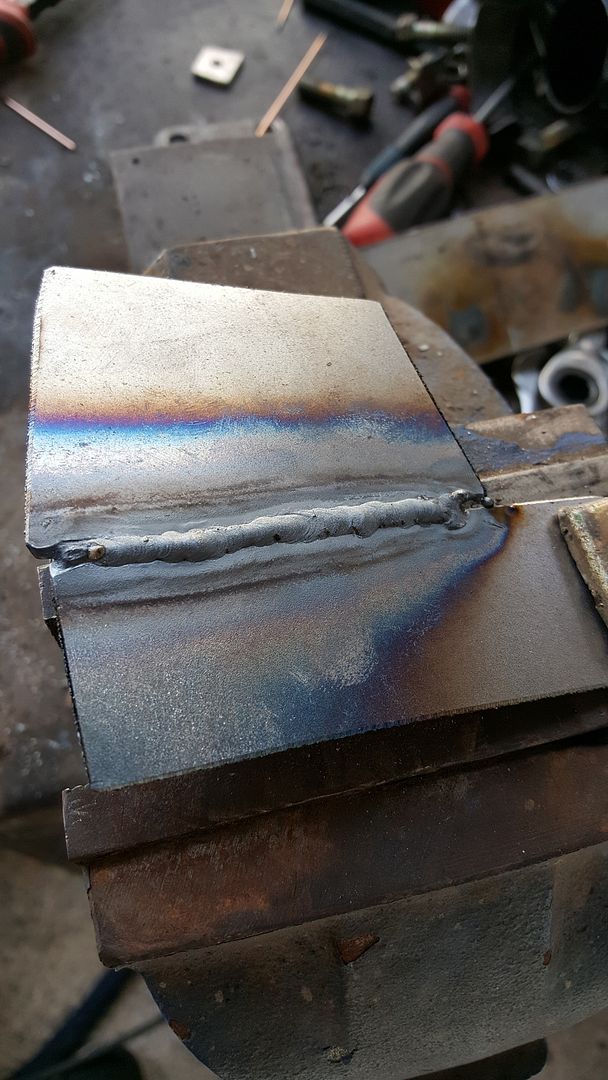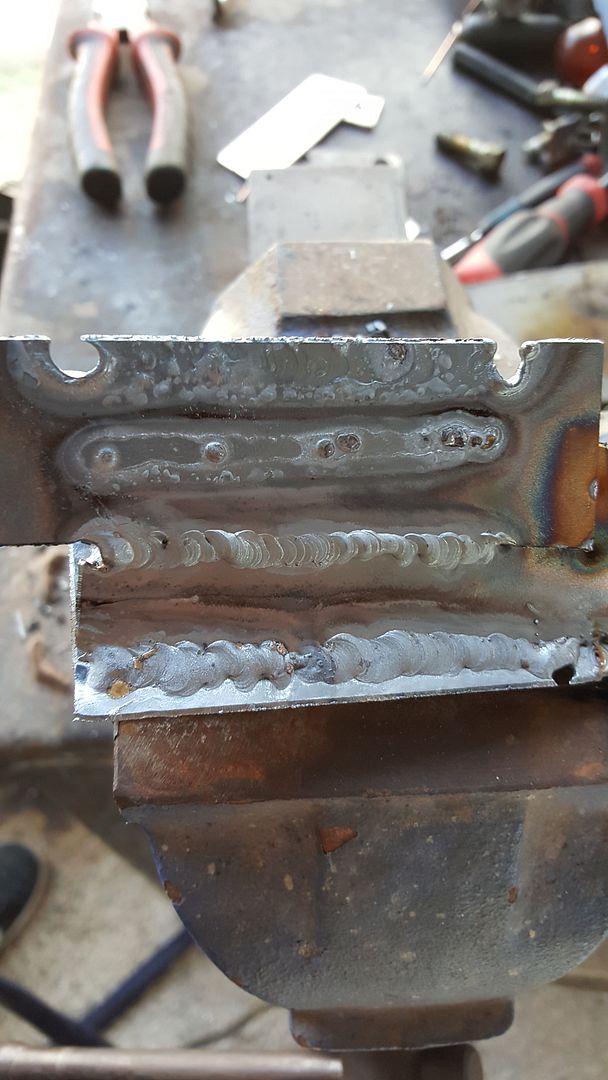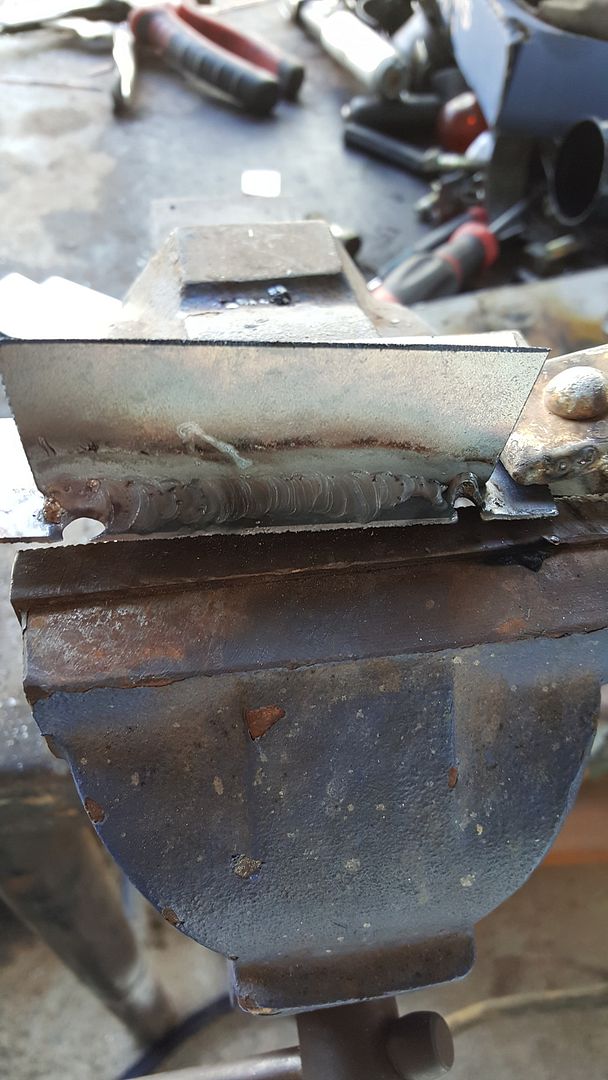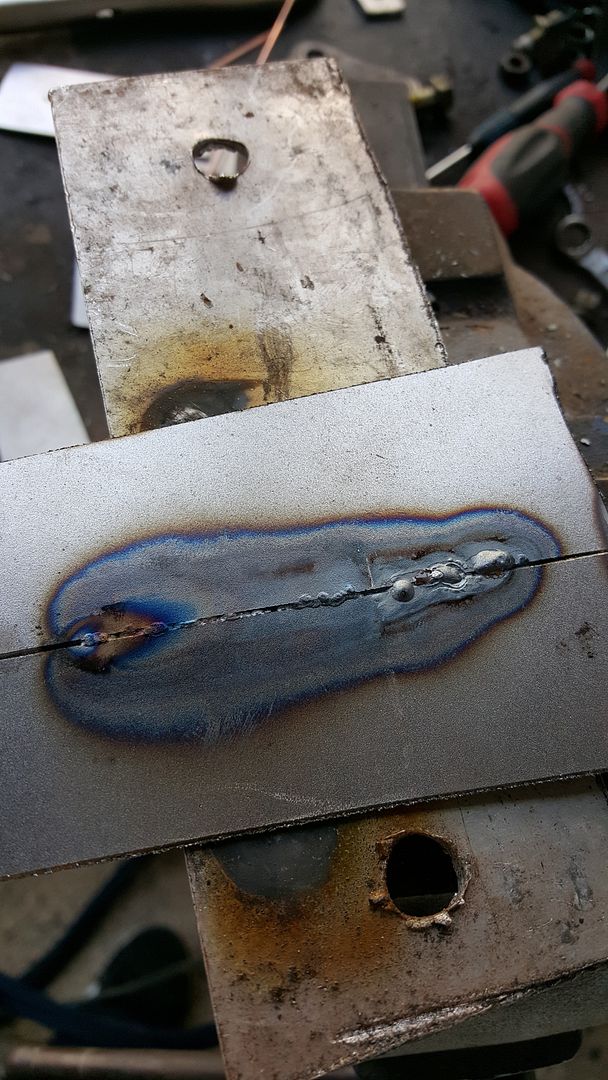Page 1 of 1
Advice...Criticism
Posted: Fri Jul 17, 2015 2:38 am
by SonOfAnarchy ZA
Re: Advice...Criticism
Posted: Fri Jul 17, 2015 9:04 am
by Rick_H
Your HAZ is pretty large so I'd say your using too much amps or your moving too slow.
What's your setup? Settings? It doesn't appear your cleaning up or grinding the edges your welding, I recommend that as it will help with some of the contamination.
When you get to he edge you need to come off the pedal if you have one as the heat has built up into the material or of you do not have a pedal feed some extra filler rod.
Re: Advice...Criticism
Posted: Fri Jul 17, 2015 9:25 am
by SonOfAnarchy ZA
Rick_H wrote:Your HAZ is pretty large so I'd say your using too much amps or your moving too slow.
What's your setup? Settings? It doesn't appear your cleaning up or grinding the edges your welding, I recommend that as it will help with some of the contamination.
When you get to he edge you need to come off the pedal if you have one as the heat has built up into the material or of you do not have a pedal feed some extra filler rod.
DC scratch start tig with only amperage setting those welds were done @40amps had a 2.4mm tungston 1.6mm er70 filler #5 cup
Re: Advice...Criticism
Posted: Fri Jul 17, 2015 9:39 am
by Louie1961
40 amps?? How thick is the material? You are generally going to need 1 amp per thousandth of an inch in thickness, give or take. 40 amps would be appropriate for 18-20 gauge steel. Your material looks thicker than that but I can't tell for sure. Having the amps too low will actually overheat your work piece. Doesn't make sense at first but it is true...Jody even has a TIG video demonstrating this.
Make sure you grind off all mill scale, clean with acetone, and always sharpen your tungsten after you contaminate it. Other than that it all comes down to keeping a tight arc length and maintaining proper torch angles.
Re: Advice...Criticism
Posted: Fri Jul 17, 2015 9:54 am
by SonOfAnarchy ZA
Louie1961 wrote:40 amps?? How thick is the material? You are generally going to need 1 amp per thousandth of an inch in thickness, give or take. 40 amps would be appropriate for 18-20 gauge steel. Your material looks thicker than that but I can't tell for sure. Having the amps too low will actually overheat your work piece. Doesn't make sense at first but it is true...Jody even has a TIG video demonstrating this.
Make sure you grind off all mill scale, clean with acetone, and always sharpen your tungsten after you contaminate it. Other than that it all comes down to keeping a tight arc length and maintaining proper torch angles.
its a 1.2mm thick sheet metal. thanks i will make sure i grind my metal clean before i weld

Re: Advice...Criticism
Posted: Fri Jul 17, 2015 1:50 pm
by Captainbeaky
I had similar problems.
It's counter intuitive - as a beginner you try and slowly "sneak up on it", but all this does is get the job really hot, and blow holes in things.
So you turn the power down, and things only get worse!
I spent an hour blowing holes in 1mm sheet until I cottoned on!
With my fixed power scratch start, I find that as soon as the melt puddle forms, I have to be ready to go, putting in some rod smartly and get the puddle moving on. Hang about, and the whole lot drops out into a hole!
Try practicing on some thicker material first - it's a bit more forgiving on 2mm, and builds the confidence.
Also, I found it very useful (instructive) to use very thin filler rod - I only had thin 0.9mm mig wire to hand, so I used that for practice, it seemed to make the process more obvious on thinner materials.
Re: Advice...Criticism
Posted: Mon Jul 20, 2015 4:27 am
by SonOfAnarchy ZA
Captainbeaky wrote:I had similar problems.
It's counter intuitive - as a beginner you try and slowly "sneak up on it", but all this does is get the job really hot, and blow holes in things.
So you turn the power down, and things only get worse!
I spent an hour blowing holes in 1mm sheet until I cottoned on!
With my fixed power scratch start, I find that as soon as the melt puddle forms, I have to be ready to go, putting in some rod smartly and get the puddle moving on. Hang about, and the whole lot drops out into a hole!
Try practicing on some thicker material first - it's a bit more forgiving on 2mm, and builds the confidence.
Also, I found it very useful (instructive) to use very thin filler rod - I only had thin 0.9mm mig wire to hand, so I used that for practice, it seemed to make the process more obvious on thinner materials.
Thanks for the reply I will keep practicing

Re: Advice...Criticism
Posted: Mon Jul 20, 2015 12:03 pm
by Oscar
No mention of arc length but everything I'm seeing points to an excessive arc length as well as too much dwelling around. If that is stainless, you need to get the puddle formed in 2s or less and learn to move, without changing arc length. You need to really practice to steady your hands or you'll never get the results you want.
Re: Advice...Criticism
Posted: Wed Jul 22, 2015 10:47 am
by SonOfAnarchy ZA
Oscar wrote:No mention of arc length but everything I'm seeing points to an excessive arc length as well as too much dwelling around. If that is stainless, you need to get the puddle formed in 2s or less and learn to move, without changing arc length. You need to really practice to steady your hands or you'll never get the results you want.
Thanks i will try keep a tighter ark length
Re: Advice...Criticism
Posted: Wed Jul 22, 2015 5:37 pm
by Boomer63
I usually start guys off on slightly thicker material. But! All is not lost! Everyone wants to throw too much amperage at first; it seems to be the thing to do. Shoot, I still want to do it! As I sit here writing this, I have four guys out in the shop who all think they need more amperage. Wait for the puddle to wet out, both sides of what you are doing. Also, cool your metal. Remember that TIG throws a LOT of heat into the base metal! Walk away from it and let it cool! Now ... here are MY thoughts on a open root joint like you are doing; many folks will disagree with me, and that is fine. I certainly don't know it all!
When I go to teach open root welding, I first have the students keep the root gap a bit tight, with lower amperage; so they don't blow holes. Then I want them to concentrate on laying down a decent bead. They don't know, but I know, that they will not get the appropriate penetration; but that will come! I have them run a inch or two, then evaluate and cool the metal. I have them do this until they are comfortable with the open root. THEN! I have them widen the root until it is where it is supposed to be for good penetration. BUT! They still have to learn to turn up that amperage ... and I have them slowly grow into the correct amperage for the thickness of material. It doesn't take that long to learn, but I have discovered that taking them through a few steps more or less speeds up the process of learning. Remember, your filler rod angle and torch angle are extremely important, in any position!
I hope I have explained myself well! Don't be afraid to ask questions! Keep after it, you will get it!
Re: Advice...Criticism
Posted: Thu Jul 23, 2015 3:38 am
by TamJeff
Get some scrap and practice pads of beads until you see them in your sleep. Then laps, then tees, and then on to open roots.
 struggeling abit not sure if u can see by the weld what im doing wrong but if you can please share
struggeling abit not sure if u can see by the weld what im doing wrong but if you can please share












